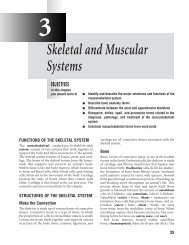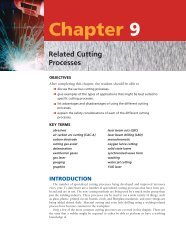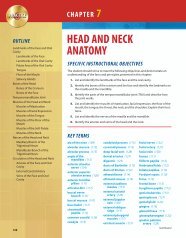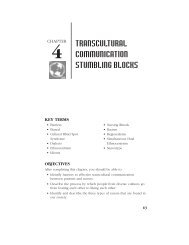Theory of Engine Operation - Delmar Learning
Theory of Engine Operation - Delmar Learning
Theory of Engine Operation - Delmar Learning
You also want an ePaper? Increase the reach of your titles
YUMPU automatically turns print PDFs into web optimized ePapers that Google loves.
Shop Manual<br />
Chapter x, page xx<br />
Preignition is an<br />
explosion in the<br />
combustion chamber<br />
resulting from the<br />
air-fuel mixture<br />
igniting prior to the<br />
spark being delivered<br />
from the ignition<br />
system.<br />
compression ratio <strong>of</strong> an engine by performing some machining operations or changing piston<br />
designs. Increasing the compression ratio may increase the power output <strong>of</strong> the engine, but the<br />
higher compression ratio increases the compression temperature. This can cause preignition<br />
and detonation. To counteract this tendency, higher octane gasoline must be used.<br />
Most gas automotive engines have a compression ratio between 8:1 (expressed as eight to<br />
one) and 10:1 and develop cylinder pressures during compression <strong>of</strong> between 125 and 200 psi.<br />
Diesel engines typically have compression ratios between 17:1 and 22:1. They can produce up to<br />
600 psi <strong>of</strong> compression pressure. The usable compression ratio <strong>of</strong> an engine is determined by the<br />
following factors:<br />
• The temperature at which the fuel will ignite.<br />
• The temperature <strong>of</strong> the air charge entering the engine.<br />
• The density <strong>of</strong> the air charge.<br />
• Combustion chamber design.<br />
Calculating Compression Ratio<br />
When calculating the total volume above the piston, the combustion chamber in the cylinder head<br />
must also be considered. The formula for calculating compression ratio is:<br />
CR 5 (VBDC 1 VCH)/(VTDC 1 VCH)<br />
where CR 5 compression ratio<br />
VBDC 5 volume above the piston at BDC<br />
VCH 5 combustion chamber volume in the cylinder head<br />
VTDC 5 volume above the piston at TDC<br />
Example: Volume above the piston at BDC 5 56 cubic inches<br />
Combustion chamber volume 5 4.5 cubic inches<br />
Volume above the piston at TDC 5 1.5 cubic inches<br />
The compression ratio would be:<br />
56 1 4.5<br />
5 10:1<br />
1.5 1 4.5<br />
Horsepower and Torque<br />
Torque is a mathematical expression for rotating or twisting force around a pivot point. As the pistons<br />
are forced downward, this pressure is applied to a crankshaft that rotates. The crankshaft<br />
34<br />
Volume before<br />
compression: 480 cc<br />
BDC<br />
Compression ratio: 8:1<br />
Volume after<br />
compression: 60 cc<br />
TDC<br />
Figure 2-24 The compression ratio is a measurement <strong>of</strong> the amount the air fuel mixture will be<br />
compressed.










